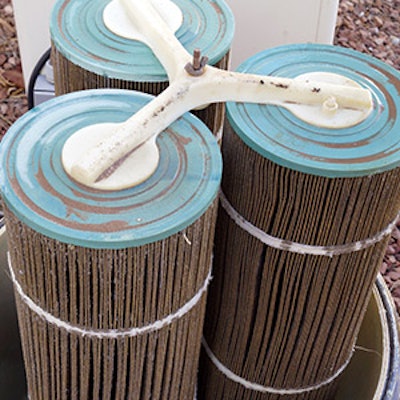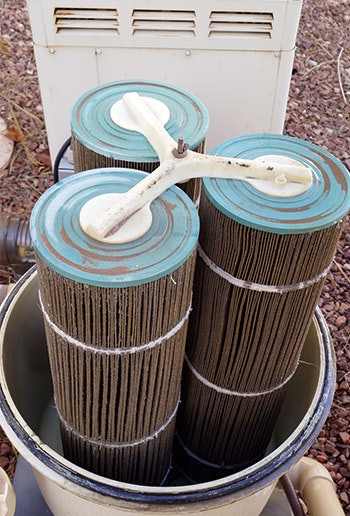

Want to make sure you land an estimate for a pool you really want on service? If the client is there with you during the estimate, offer to clean their filter. Why, you ask? It's simple. The filter has probably been neglected, which is why they are looking for a new service company in the first place. (Well, indirectly anyways.) In any case, if you can show them the dirty filter, you've already proven yourself more valuable than their last company. As long as you nail the rest of your presentation (estimates are essentially presentations, right?), you'll walk back to your truck with one more account to add to your list.
Let me side step for one moment to preface all of what you're about to read. There are three main ways to end up with a potentially unsafe and/or green pool. The first is chemically. The second is from improper circulation and filtration (likely caused by DIRTY FILTERS). The third is a combination of the first two. So you can see why properly maintaining filtration equipment is at the top of the priority list.
RELATED: How Filters and Chemicals Work Together to Keep the Pool Water Clean
The Price of Neglect
When I gain a new account, I clean the filter on my very first visit. Not only can this become a sales opportunity for you, but it also makes you look like a professional to your new clients. I've had a client call me literally after servicing their pool, noting I cleaned their filter and admitting they didn't know the filter was even supposed to be cleaned. Poor clients.
But cleaning them takes time — precious time that busy service pros are sometimes reluctant to spend. So while maintaining the filter is one of the most quintessential things we can do as pool service men and women, it's oftentimes neglected. Yes, it may take 10-15 minutes to clean each filter. No doubt that will slow up your day. However, wouldn't you rather take 10-15 minutes out of your day now to avoid 2-3 hours of clearing up a green pool?

When Can I Tell It's Time To Clean The Filter?
I get this question from clients all the time. It's virtually impossible to put a time limit on when it's time to clean the filter, so don't even try. There are just too many variables. You need to consider things like the pools' volume, run time, filter sizing, pump sizing, chemicals used…even if dogs swim in it frequently. That's just the beginning of what can impact the filter, and therefore affect when it's time to clean it.
Even when your clients ask for a time schedule for cleaning, saying you're going to clean filters according to the calendar — say, once every six months — is truly doing them a disservice. While some of the filters on the route may make it, there are others that are screaming for a bath.
Of course, that little filter gauge on top of the filter is the key. I tell everyone it measures the internal health of the filter. So if the gauge is broke, fix it.
Whatever the pressure gauge reads after you replace/clean the filter and bleed out the air is called the "starting pressure." (If you don't have a gauge with a sliding "clean/dirty" bezel on it, you can take a permanent marker and mark the PSI at the appropriate points.) Once it gets to 10 psi over that starting pressure, it's time to clean the filter. It doesn't matter what size or type the filter is. Sticking to this standard will make you a filter all-star.
Okay, the filter is dirty. How do I clean it?
Cartridge Filter:
If you have a cartridge filter, remove the element and wash it down with a garden hose. I love using a standard spray nozzle. I've tried the fancy pool-specific ones, but I always end up going back to the standard nozzle. Do not use a pressure washer on the cartridge, as you will more than likely puncture a hole through the cartridge. (And then you'll be on the hook for replacing it.) Wash all of the pleats until dirt no longer comes out of the bottom.
TIP: Most of the dirt/mud/gunk is packed in the bottom ¼ of the cartridge. Spend most of your time there.
Sand or D.E. Filter:
If you have a sand or D.E. filter, hopefully you'll be lucky enough to find the installer hard plumbed the waste line so you don't have to roll out the backwash hose. If not, I feel for you.
Run the hose to a safe place and turn the multiport to backwash. Run the system in backwash for 30-90 seconds, or until the sight glass is clear. Then turn the multiport to "rinse," if that option is available. Run it again for 30 seconds or so to clear out the lines. Repeat this process 2-3 times. At this point, turn the valve back to "filter."
TIP: If the label is worn off, "backwash" is always opposite of "filter."
If you have a sand filter, you're all done. If you have D.E., you have to recharge the filter with fresh D.E. powder through the skimmer. Then you're done!
RELATED: The Dirt on Filter Cleaning
Filter "DO's":
- Do clean them frequently
- Do monitor them during each visit
- Do suggest replacement elements/parts BEFORE they cause a larger problem
- Do manipulate the filter lid to where the gauge is easily readable in passing so you can easily monitor them each visit
Filter "DON'T's":
- Don't guess when a filter needs to be cleaned
- Don't assume all filters can go the length of time in-between cleanings
- Don't attempt to monitor a filter with a broken gauge. Fix it ASAP
- Don't think you're doing your clients a favor by letting the worn parts ride. They will fail. Then they'll be asking you for answers.
Erik Taylor, a.k.a. "The Chlorine King" is CPO-certified and owner of Chlorine King Pool Service, Seminole, Fla. He can be reached for comment at [email protected].












































